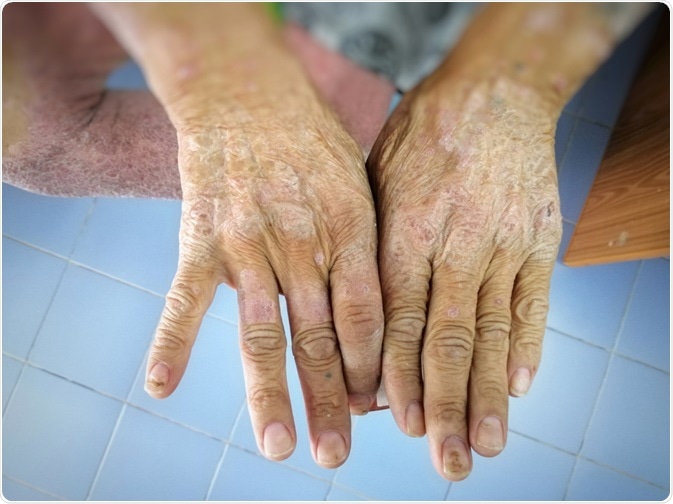Scleroderma is a health condition that involves the hardening of the skin and some organs in the body. Although the term we use to describe the condition today was not first used until the nineteenth century, there have been some records of the condition and its characteristic symptoms throughout history, as early as 400 BC.
 Image Credit: Numstocker/Shutterstock.com
Image Credit: Numstocker/Shutterstock.com
Term derivation
The word scleroderma used to describe the health condition originates from the two Greek words skleros and derma, which mean hard or indurated and skin respectively.
The term was first penned in 1836 by Giovambattista Fantonetti, who described the symptoms of a patient with dark, leathery skin that led to skin tightening and a decrease in the range of joint motion. The condition was termed “scleroderma generale”.
Patients with symptoms of scleroderma have been referred to at several points throughout history, however, the name we use currently use to refer to the condition was not used until the nineteenth century.
Ancient writings
Early reports that contain evidence of scleroderma, and patients with the characteristic symptoms of the condition, date as far back as 400BC. Hippocrates (460-370 BC) described the condition by referring to the “thickened skin” that appeared on people affected by the condition.
Additionally, some records show that other scholars in a similar time period also wrote about a disease with symptoms of thickened skin, including Oribasias (325-403 A.D.) and Paulus Agineta (625-690 A.D). However, it is not entirely clear if these records indicate sclerosis or another disease, as the written descriptions are not an exact representation of the condition.
First description
An Italian doctor from Naples, Carlo Curzio, wrote the first detailed description of the health condition in the mid-1700s, approximately 1752 or 1753.
He described the symptoms experienced by patients with sclerosis (although the exact term was still not in common use) as hard, wood-like skin, similar to that of a dry hide. This account was received with considerable interest among medical circles, particularly those in France and England.
The patient, a 17-year-old female Patrizia Galiera, was admitted to the hospital under the care of Curzio. Her symptoms included hardness of skin in various areas, tightness around the mouth and hardness around the neck. The skin felt cool, but there were few other notable symptoms.
The treatment Curzio used involved warm milk and vapor baths, complemented by bleeding from the foot and small quicksilver doses. Within a year, the skin returned to its natural state, with normal softness and flexibility. These findings stirred interest among medical scholars of that time.
Scleroderma - an Osmosis Preview
Current epidemiology
As we currently understand the condition of scleroderma, it is a relatively rare condition and the prevalence varies considerably according to the location in the world. Women are more likely to be affected than males with a relative risk of 4 to 9 times higher.
In the United States, the prevalence is approximately 276 cases per million people in the population, with an incidence of 20 new cases per million per year. Over the past 50 years, both the prevalence and incidence of the condition appear to be increasing, although it is not clear if this is due to a rise of the condition or improved diagnostic tests.
References
Further Reading